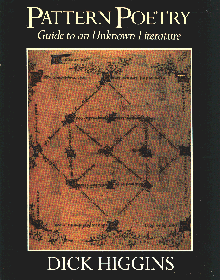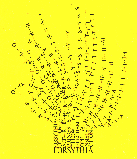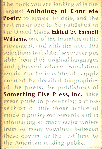 George Herbert's Pattern Poems: In Their Tradition, by Dick
Higgins (West Glover, Vermont and New York, New York: Unpublished Editions,
1977).
George Herbert's Pattern Poems: In Their Tradition, by Dick
Higgins (West Glover, Vermont and New York, New York: Unpublished Editions,
1977).
1. A detailed history of this artform can be found in Concrete Poetry: A World View, Mary Ellen Solt ed. (New York: Indiana Univ. Press, 1967).
2. Particularly there is his The Chinese Written Character as a Medium for Poetry which he wrote with Ernest Fenollosa and published in the journal Instigations in London in 1920. However incorrect he may have been about the meaning and function Chinese ideograms, this document was a significant extension of Pound's imagist technique of poetry which was influential among poets of the fifties. With Wyndham Lewis, Pound founded Vorticism in 1914 which was something of a synthesis of Cubism and Italian Futurism (though very much opposed to their brand of shock art). Lewis was heavily influenced by early Cubist paintings and those aspects derived "from remote antiquity or the art of primitive peoples." Lewis made extensive use of typography and graphic space to convey meaning in the Vorticists' journal BLAST, which also published Pound's more experimental poems and aesthetic theories which were reexamined by many artists after World War II. See Vorticism: An Abstract Art in the First Machine Age, by Richard Cork (Berkeley: University of California, 1976. Two Volumes). Also see, The Pound Era, by Hugh Kenner (Berkeley: University of California, 1971).
3. Theo van Doesburg, by Joost Baljeu (New York: Macmillan Publishing Co., 1974). Theo Van Doesburg (1883-1931) was an architect who had been influenced by the writings of F. T. Marinetti and Wassily Kandinsky. He developed a close association with Kurt Schwitters and Berlin Dada manifestation, and founded under the pseudonym, I. K. Bonset, Holland Dada through a series of highly influential literary manifestos and poems. Van Doesburg's poetry in the guise of Bonset, was made up of mathematical symbols and numbers as well as phonemes and letters printed in a unique typographical style. He published two Holland Dada magazines called Mecano and Art Concret which had a significant influence upon the visual poets of the nineteen fifties. Along with Piet Mondriaan, Van Doesburg founded the magazine de Stijl in 1917 which not only published the work of the Holland avant-garde but also the writings and poems of other Dadaist such as Schwitters, Hugo Ball, Tristan Tzara, and Hans Arp, as well as the Italian Futurist Fino Severini and the American Composer George Antheil.
4 Though "figurative verse" was nothing new (see [8]) in poetry, Guillaume Apollinaire radically expanded the possibilities of this way of working with pieces which he called Calligrammes, which were poems that visually imitated the meaning of the words which were used in them. Calligrammes: Poems of Peace and War (1913-1916), by Guillaume Apollinaire, translated by Anne Hyde Greet (Berkeley: University of California Press, 1980).
5. In particular his radical use of blank space to convey meaning in his 1897 classic "Un Coup de Dés / jamais n' abolira le Hasard" ("The Dice Throw / Will Never Do Away with Chance"). A challenge to the typesetters of the time, the poem was subsequently incorrectly laid out and generally badly printed for the most part ever since.
6. Perhaps the "best-known example in English of emblematic, or figured, verse" is Lewis Carroll's "mouse's tale". The Annotated Alice: Alice's Adventures in Wonderland & Through the Looking Glass, by Lewis Carroll, with an Introduction and Notes by Martin Gardner (New York: Clarkson N. Potter, Inc., 1960. pp. 50-51).
7. George Herbert (1593-1633)
was an active proponent in Elizabethan England of an ancient tradition of
visual poetry and who produced a number of exemplary pattern verses at that
time.
 George Herbert's Pattern Poems: In Their Tradition, by Dick
Higgins (West Glover, Vermont and New York, New York: Unpublished Editions,
1977).
George Herbert's Pattern Poems: In Their Tradition, by Dick
Higgins (West Glover, Vermont and New York, New York: Unpublished Editions,
1977).
8. An "introductory" history to this massive literature can be found in Pattern Poetry: Guide to an Unknown Literature, by Dick Higgins (New York: State University of New York Press, 1987).
9. The term was taken from Ezra Pound's Canto XX, "Noigandres, eh noigandres / Now what the DEFFIL can that mean!"
10. Their conception of an ideogram derived from James Joyce's Finnegans Wake, "makes it possible for the concrete poem to partake of 'the advantages of nonverbal communication,' without sacrificing the 'virtualities' of the word. As the result 'metacommunication: coincidence and simultaneity of verbal and nonverbal communication' occurs." Solt, p. 14.
11. An English translation has been published in Literally Speaking: sound poetry & text-sound composition, edited by Teddy Hultberg (Sweden: Bo Ejeby Edition, 1993). Fahlström was a key figure in the foundation of text-sound composition: "Settled in New York in the early 60's, with frequent visits to Sweden, during the summers, he became an important mediator between the New York avant-garde and Swedish contemporary artists." His early radio play for Swedish Radio, "Fåglar i Sverige" ("Birds in Sweden') in 1963 was of seminal importance to the later architects of text-sound composition.
12. Some other of the many sources to examine on this subject are:
"Concrete Poetry" by Mike Weaver, in The Journal of Typographical
Research, Vol. 1, No. 3 (Cleveland: The Press of Western Reserve
University, July 1967).

An Anthology of Concrete Poetry, edited by Emmett Williams (New York: Something Else Press, 1967).
Concerning Concrete Poetry (London: Writers Forum, 1978).
Speaking Pictures: A gallery of pictorial poetry from the sixteenth century to the present, edited by Milton Klonsky (New York: Harmony Books, 1975).
Visual Poetry Anthology: 133 poets from 25 countries, edited by g. j. de rook (Utrecht: Bert Bakker Den Haag, 1975).
Múzsával Vagy Múzsa Nélkül? (Irodalom Számítógépen), by Tibor Papp (Budapest: Balassi Kiadó, 1992). The use of computers to produce visual poetry has recently expanded all over the world and is extensive in every locality. This is a recent survey of this development from a Hungarian perspective.
Some Internet information on Concrete Poetry:
The Ruth and Marvin Sackner Archive of Concrete and Visual Poetry (perhaps the largest in the world), can be searched on line.
The University of California at San Diego has extensive holdings (as well as a biography and bibliography) of works by the well-known Scottish visual poet, Ian Hamilton Finlay.
Images::
The John Furnival and the Dom Silvester Houédard examples are from GLOUP and WOUP, edited & introduced by Bob Cobbing (Kent, England: Arc Publications, 1974).
The Décio Pignatari example is on page 108 of the Solt book.